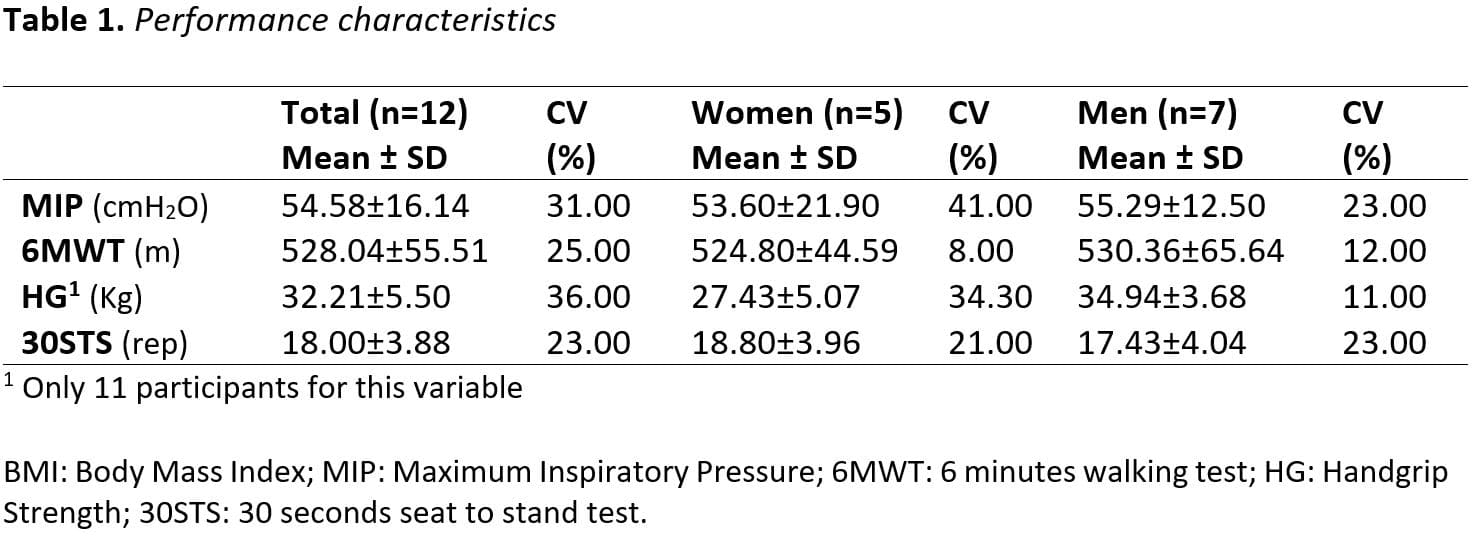Lack or little relationship between the strength of the inspiratory muscles and the functional capacity in a group of healthy active elderly undergoing a multicomponent training program (MCTP), suggest the assessment of the Maximum Inspiratory Pressure (MIP) and its specific training to ensure cardiorespiratory health in neuromuscular interventions (1). In order to deepen in this rationale, the present study reproduces the experimental procedure and testing methodology in a group of Portuguese elderly undergoing a different MCTP. Training dose was larger (three days/week vs two days), and cognitive demands were reduced compared to EFAM-UV© (1). 12 healthy, active, non-smokers elderly (73.08±6.08 years; 54.58±16.14 cmH2O; 5 women: 73.40±7.67 years, 53.60±21.90 cmH2O; 7 men: 72.86±5.37 years, 55.29±12.50 cmH2O) volunteered to participated. MIP was assessed by means of the Powerbreathe© K5 (2), following Neder, Andreoni (3) protocol. Functional capacity included: cardiorespiratory fitness (6MWT), and upper-limb and lower-limb strength tests (Handgrip & 30STS). The association between MIP and functional capacity was analysed, and age and gender were introduced as covariates. The Portuguese sample showed MIP values closed to those expected for the Powerbreath© K5 in similar samples (1, 4), but only gender showed a significant a priori association with the handgrip (r=0.690; p<0.05). MIP, 6MWT and 30STS failed to show it. In disagreement with previous studies in elderly undergoing EFAM-UV© (1), there was lack of association between MIP and the functional capacity outcomes in the Portuguese group. This study underspin the small association between MIP and functional capacity in elderly following neuromuscular training when considering the influence of age and gender. Larger dose and reduced cognitive demands do not improve this relationship, so specific inspiratory training should be added to MCTP, although the small sample size is an important limitation in our study. In fact, Giua, Pedone (5) found a relationship between MIP and 6MWT in a group of elderly (men and women), without considering our covariates, and predicted the 6MWT including MIP in the formula, what increased the explained variability from 22% to 34%. On the other hand, differences in testing devices (traditional vs. electronic) is also a limitation and suggests the need of further studies with better normative references, and bigger samples of healthy active individuals.
Physiology 2019 (Aberdeen, UK) (2019) Proc Physiol Soc 43, PC096
Poster Communications: Maximum inspiratory pressure vs functional capacity in Portuguese active elderly undergoing Multicomponent Training
C. Blasco-Lafarga2, A. Roldán1, N. Blasco-Lafarga3, M. Gómez-Cabrera4, J. R. Duarte5, J. Carvalho5
1. Physical Education and Sport Department, University of Valencia, Valencia, Valencia, Spain. 2. Physical Education and Sport Department, University of Valencia, Valencia, Spain. 3. Primary Health Centre in Peset Hospital area, Valencia, Spain. 4. Physiology Department, University of Valencia, Valencia, Spain. 5. Research Centre in Physical Activity Leisure and Health, Faculty of Sports, University of Porto, Porto, Portugal.
View other abstracts by:
Table 1. Performance and functional capacities1 Only 11 participants for this variableBMI: Body Mass Index; MIP: Maximum Inspiratory Pressure; 6MWT: 6 minutes walking test; HG: Hangrip Strength; 30"STS: 30 seconds seat to stand test
Where applicable, experiments conform with Society ethical requirements.

